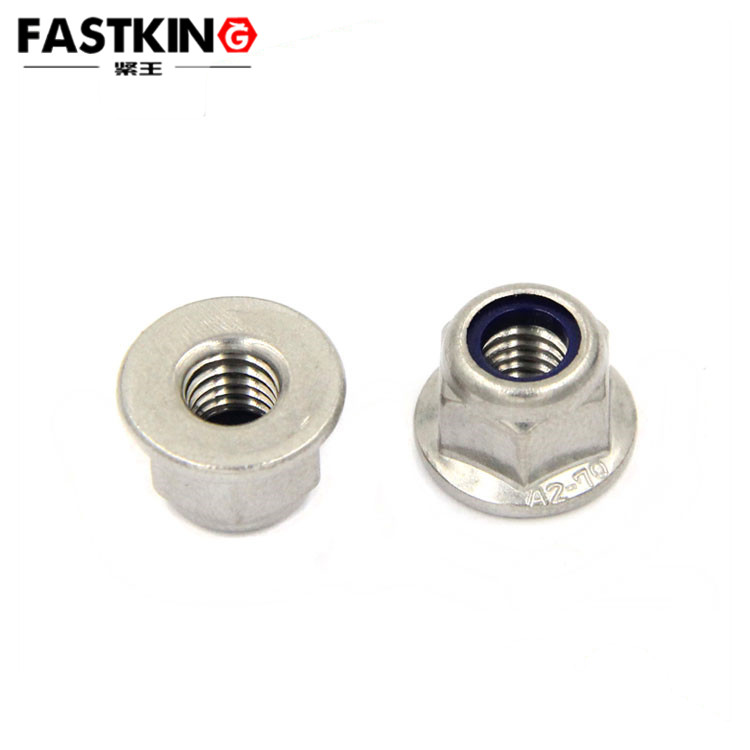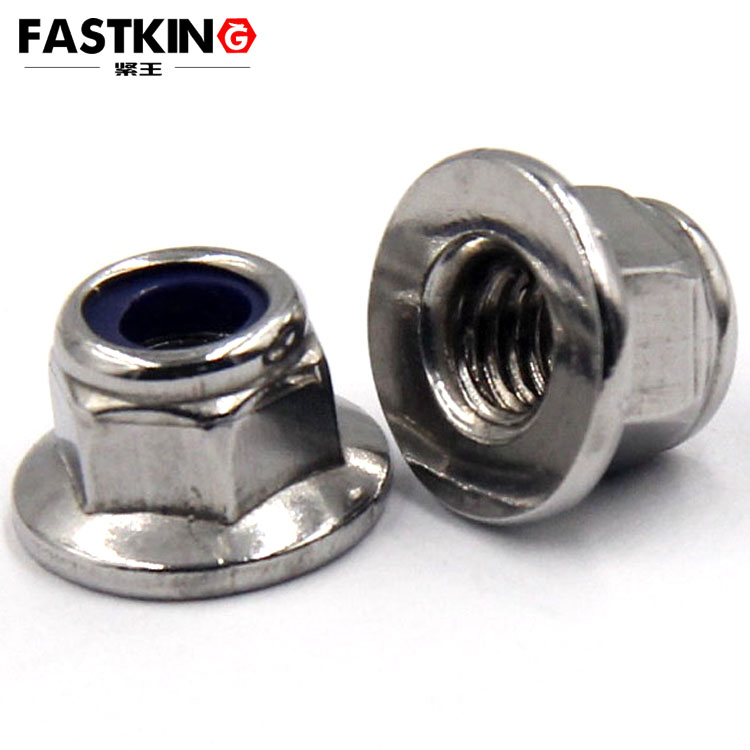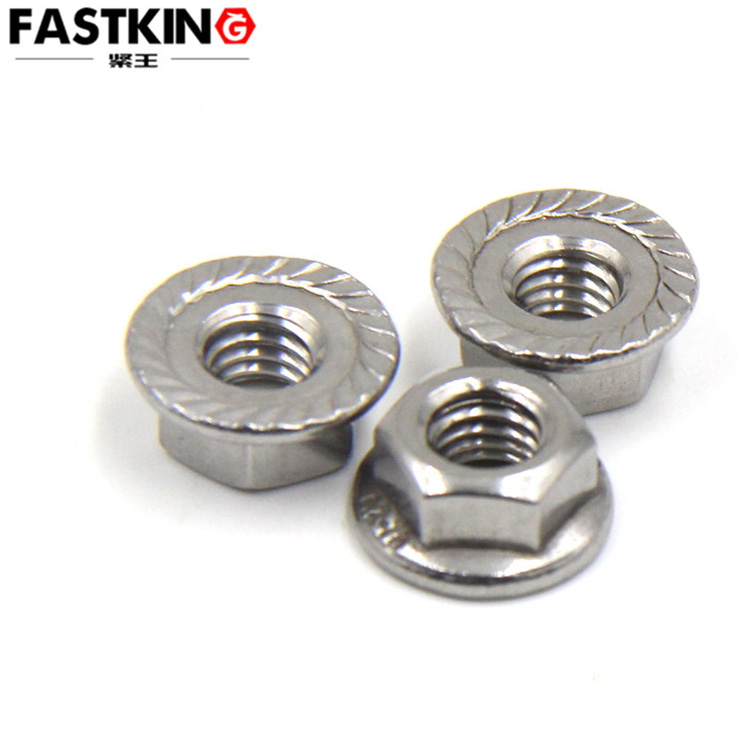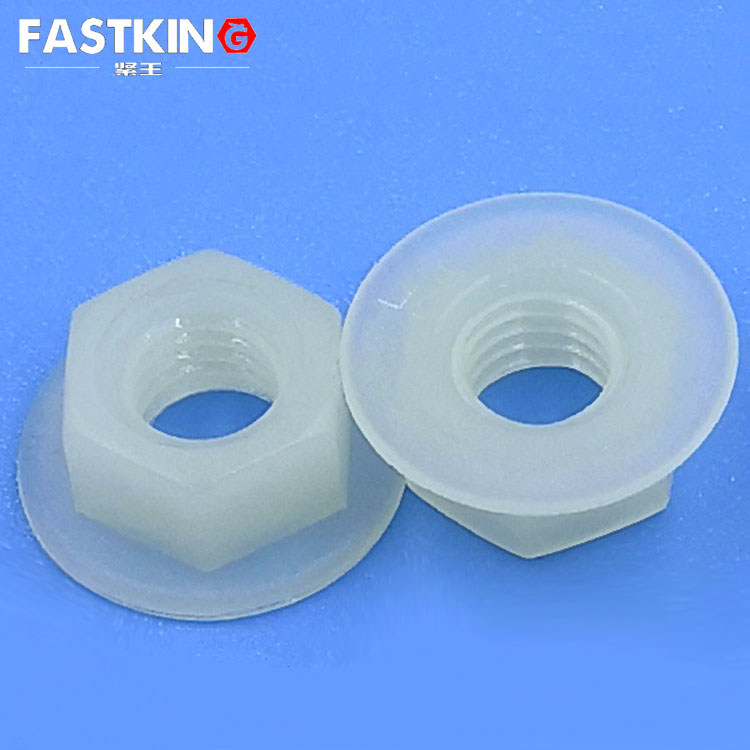- ZHUHAI JIALI HARDWARE CO.,LTD.
- 0760-85889089
Flange nylon lock nut-din6926
- Product description:Flange nylon lock nut-din6926
1. Flange Face: Foundation for Anti-Slip Performance and Force Distribution
Compared with ordinary hexagon nuts, one end of the flange face nylon lock nut is integrated with an outwardly extending "disc-shaped flange" — a structure directly inheriting the design logic of flange nuts:
- Dimensional Design: The outer diameter of the flange is typically 30%-50% larger than the hexagon head of the nut (e.g., the across-flats distance of an M10 nut’s hexagon head is 16mm, while the flange outer diameter can reach 22-24mm). The bottom of the flange face is also processed with evenly distributed anti-slip serrations (or a smooth surface, selected based on working conditions);
-
Core Functions: First, "increasing contact area" — when the nut is tightened, the wide flange face distributes the tightening force across the surface of the connected component, preventing deformation of vulnerable parts (such as thin plates or plastic components) caused by excessive local pressure. Second, "anti-slip positioning" — the anti-slip serrations on the flange face can embed into the surface of the connected component, creating physical anti-slip resistance. This is particularly effective in preventing relative sliding between the nut and the connected component under vibration, an advantage not offered by ordinary nylon lock nuts.

2. Nylon Anti-Loosening Ring: Core Barrier for Long-Term Anti-Loosening
On the opposite end of the nut (relative to the flange face), a nylon anti-loosening ring is embedded via injection molding — the core anti-loosening structure of nylon lock nuts, which forms "bidirectional protection" with the flange face:
- Material & Specifications: The nylon ring is mostly made of nylon 66 (with a maximum temperature resistance of 120℃); modified nylon (e.g., PA66 + glass fiber, with temperature resistance up to 150℃) is used for high-temperature scenarios. The inner diameter of the nylon ring is slightly smaller than the minor diameter of the bolt thread (interference fit), ensuring elastic interference when engaged with the bolt;
- Anti-Loosening Principle: When the nut is tightened onto the bolt, the nylon ring is compressed and deformed. Its elastic material fills the flank clearance of the bolt thread: on one hand, the elastic restoring force continuously applies radial pressure to the thread pair, maintaining positive pressure between threads; on the other hand, the deformed nylon ring forms "engagement locking" with the threads. Even under high-frequency vibration, this prevents circumferential rotation of the nut relative to the bolt, achieving long-term anti-loosening.
3. Nut Body: Main Carrier for Strength and Load-Bearing
The body is made of high-strength materials, serving as the core carrier for connection and force-bearing:
- Material Selection: Q235 carbon steel (with galvanized or Dacromet surface treatment for rust resistance) is used for general scenarios; 304 stainless steel is suitable for humid or slightly corrosive environments; 45# carbon steel (quenched and tempered, with tensile strength ≥600MPa) is used for high-strength heavy industrial scenarios (e.g., construction machinery);
- Thread Precision: The internal thread precision complies with GB/T 197 (tolerances for general purpose metric threads), forming a precise fit with bolt threads (usually 6g precision). This avoids reduced anti-loosening effects due to excessive thread clearance while ensuring connection strength.
Compared with the combination of "flange nut + ordinary nylon nut", the integrated structure of the flange face nylon lock nut completely eliminates issues such as "misalignment or loss of multiple components during assembly". A single nut can achieve "anti-slip + anti-loosening + fastening", significantly simplifying the assembly process.
II. Core Advantages: More Comprehensive Adaptability to Working Conditions Than Single-Function Nuts
The competitiveness of flange face nylon lock nuts lies in their "comprehensive functionality" — they not only address the shortcoming of ordinary flange nuts (lack of anti-loosening capability) but also solve the problem of ordinary nylon lock nuts (insufficient anti-slip performance), demonstrating significant advantages in three dimensions:
1. Dual Protection (Anti-Loosening + Anti-Slip) for Complex Working Conditions
Ordinary nylon lock nuts can only prevent circumferential loosening of the nut relative to the bolt but cannot avoid relative sliding between the nut and the connected component. Flange nuts, while effective for anti-slip, are prone to thread pair loosening under vibration. In contrast, the "flange face + nylon ring" combination of flange face nylon lock nuts provides "bidirectional protection":
- In high-vibration scenarios (e.g., automotive chassis, power tools), the nylon ring blocks thread pair loosening, while the anti-slip serrations on the flange face prevent sliding between the nut and the connected component. This dual protection improves connection reliability by 2-3 times compared to single-function nuts;
- Third-party test data shows that in a 1000Hz high-frequency vibration test, ordinary nylon lock nuts experienced a 30% preload loss after 4 hours, while flange face nylon lock nuts had a preload loss of less than 5% after 8 hours, with no significant anti-slip displacement.
2. No Additional Accessories Required, Higher Assembly Efficiency
In traditional solutions, achieving both anti-slip and anti-loosening requires sequential installation of "bolt + flat washer + flange nut + nylon nut". Assembling multiple components is not only time-consuming but also risks protection failure due to component misalignment. The flange face nylon lock nut integrates all functions into one unit — workers only need to pick up a single part and tighten it once to complete assembly, increasing efficiency by over 50% compared to traditional solutions. For example, after switching to flange face nylon lock nuts for engine bracket assembly, an automotive component factory increased the daily output of each production line from 800 sets to 1300 sets, and reduced the rework rate from 8% to 0.5%, directly cutting labor and time costs.
3. Low Environmental Requirements, Wide Applicability
The anti-loosening effect of ordinary solutions (e.g., spring washers, lock washers) is easily affected by the environment — spring washers are prone to rust failure in humid conditions, and lock washers may undergo plastic deformation at high temperatures. The protective structure of flange face nylon lock nuts has stronger environmental adaptability:
- The nylon ring has excellent corrosion resistance, eliminating concerns about humid or mild chemical corrosion affecting anti-loosening performance;
- The anti-slip serrations on the flange face do not rely on additional lubrication or protection, maintaining anti-slip performance even in harsh environments with dust or oil;
-
Combined with nut bodies with different surface treatments (e.g., Dacromet, galvanization), they can be used in outdoor, chemical, marine, and other scenarios, covering all needs from home decoration to industrial applications.

III. Typical Application Scenarios: Focus on Fields Requiring Both "Anti-Slip + Anti-Loosening"
The characteristics of flange face nylon lock nuts make them indispensable in scenarios where both "sliding" and "loosening" issues need to be addressed. Typical applications are divided into four major fields, with differences in requirements reflected mainly in specification and material selection:
1. Automotive Industry: Dual Challenges of Vibration and Lightweight Design
The chassis, engine peripherals, and interior components of automobiles are core application scenarios for flange face nylon lock nuts:
- Chassis Suspension System (e.g., stabilizer bar connections, control arm fixing): Subject to high-frequency vibration and impact loads. The anti-slip serrations on the flange face prevent sliding between the nut and chassis steel plates, while the nylon ring prevents thread loosening, ensuring vehicle driving stability;
- Engine Accessories (e.g., water pump brackets, generator fixing): Engines operate at high temperatures (up to 100-120℃). Flange face nuts with heat-resistant modified nylon rings are used to provide anti-loosening performance, while the flange face distributes pressure to avoid bracket deformation;
- Interior Components (e.g., seat rails, instrument panel fixing): Connected components are mostly thin plates or plastic parts. The flange face protects components from crushing, and the nylon ring prevents interior loosening and noise during vehicle operation.
2. Construction Machinery and Agricultural Equipment: Reliable Connection Under Harsh Conditions
Construction machinery (excavators, loaders) and agricultural equipment (tractors, harvesters) operate in outdoor environments with dust, mud, and 颠簸 (jolts), requiring high anti-slip and anti-loosening performance from nuts:
- Excavator Bucket Connections: Subject to massive impact loads. Flange face nylon lock nuts with 45# carbon steel bodies are used — the anti-slip serrations on the flange face embed into the bucket steel plates, and the nylon ring prevents thread loosening, reducing maintenance frequency;
- Tractor Implement Hitches: Require frequent disassembly and outdoor operation. Flange face nuts achieve anti-slip without additional washers, and the nylon ring ensures implements do not loosen during operation, guaranteeing safety.
3. Electronics and Home Appliance Industry: Needs for Lightweight Design and Low Noise
Components of electronic devices and home appliances are mostly miniaturized and lightweight, with requirements to avoid vibration-induced noise:
- Server Cabinets (e.g., crossbeam, tray fixing): Cabinets generate slight vibration during long-term operation. The flange face prevents sliding between the nut and cabinet thin plates, and the nylon ring avoids component displacement due to thread loosening;
- Washing Machines and Air Conditioners (e.g., motor end caps, drum brackets): Motors generate vibration during operation. The flange face distributes pressure to protect plastic end caps, and the nylon ring prevents loosening and noise. Meanwhile, the integrated design simplifies assembly, adapting to mass production on home appliance lines.
4. Construction and Outdoor Facilities: Outdoor Weather Resistance and Long-Term Stability
Outdoor facilities in construction (e.g., street lamps, guardrails) are exposed to wind and rain for long periods, requiring stable connections:
- Street Lamp Base Fixing: Flange face nylon lock nuts made of 304 stainless steel are used — the flange face fits the base flange for anti-slip, the nylon ring provides anti-loosening, and the stainless steel material resists outdoor rust, ensuring a service life of over 10 years;
- Outdoor Guardrail Connections: Guardrails are prone to vibration from wind. The anti-slip serrations on the flange face prevent nut sliding, and the nylon ring avoids thread loosening after long-term use, reducing maintenance costs.
IV. Selection and Usage Precautions: Maximizing Functionality
Despite the wide applicability of flange face nylon lock nuts, details in selection and installation directly affect their performance. The principles of "matching working conditions and standardized operation" should be followed:
1. Selection: Matching Key Parameters to Working Conditions
- Specification Matching: The thread specification must fully match the bolt (e.g., M8 bolts with M8 flange face nylon lock nuts). Meanwhile, the nut height should be selected based on the thickness of the connected component to ensure full engagement between the nylon ring and the bolt, and complete fitting of the flange face to the component surface;
- Material Selection: Galvanized carbon steel is used for dry indoor scenarios (e.g., home appliances, electronic devices) for low cost; 304 stainless steel is preferred for outdoor or humid scenarios (e.g., street lamps, guardrails); carbon steel bodies with modified nylon rings are used for high-temperature scenarios (e.g., engine peripherals); quenched and tempered 45# carbon steel is used for high-strength scenarios (e.g., construction machinery);
- Flange Face Type: Smooth flange faces are suitable for vulnerable connected components (e.g., plastic, thin plates); flange faces with anti-slip serrations are used for materials requiring strong anti-slip performance (e.g., steel, aluminum).
2. Installation: Avoiding Operational Mistakes That Affect Performance
- Tool Compatibility: Use open-end wrenches or box-end wrenches matching the nut’s hexagon head. Avoid over-clamping with adjustable wrenches to prevent deformation of the hexagon head. Ensure the flange face fits completely and evenly with the component surface during tightening, with no tilting;
- Torque Control: Use a torque wrench to tighten according to the recommended torque (e.g., the recommended torque for M10 flange face nylon lock nuts is 25-30N・m). Over-tightening may break the nylon ring, while insufficient torque fails to achieve anti-loosening effects;
- Environmental Considerations: Ordinary nylon ring products are not suitable for high-temperature scenarios (exceeding 120℃); heat-resistant modified nylon rings must be used instead. If anti-slip serrations on the flange face are damaged after installation, replace the nut promptly to avoid reduced anti-slip performance.
V. Conclusion: A Typical Example of Functional Integration in Fasteners
The design of flange face nylon lock nuts is not a disruptive innovation of traditional nuts, but a solution to the pain points of single-function nuts through "functional integration". By combining the anti-slip advantages of flange nuts and the anti-loosening advantages of nylon lock nuts, it achieves a "1+1>2" effect with a more concise structure. Amid modern industry’s pursuit of "reliability, efficiency, and cost-effectiveness", this integrated design is increasingly becoming an important direction in fastener development.
Essentially, the value of flange face nylon lock nuts lies in "precisely matching the needs of complex working conditions". Instead of pursuing extremes in a single function, it balances multi-dimensional requirements (anti-slip, anti-loosening, assembly efficiency) to become the "optimal solution" for many scenarios. This user 需求 (demand)-driven design logic not only secures its stable position in the fastener market but also provides a "functional integration" reference for innovation in other fasteners, confirming the industry principle that "small components can create great value through optimized design".



